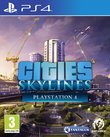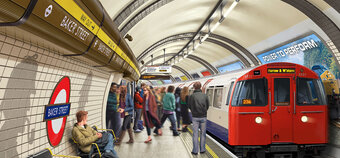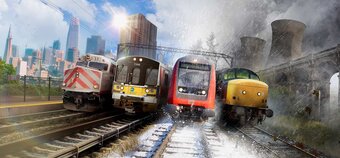It's always the way isn't it. You're stuck in traffic, wasting your life staring at a ten mile long tailback, all because the council have decided to implement some "traffic improvement" measures. "Why didn't they just get it right the first time", you grumble to yourself under your breath. "How hard can it be?". Then a game like Cities Skylines comes along - a game that lets you plan your very own city from scratch - and you quickly find out. When you're only a few hours in and there's dead bodies piling up on street corners, traffic jams stretching for miles out of town, employers are shutting up shop, power cuts last for weeks, and almost everything's on fire, you quickly realise that planning a city isn't as easy as it looks.
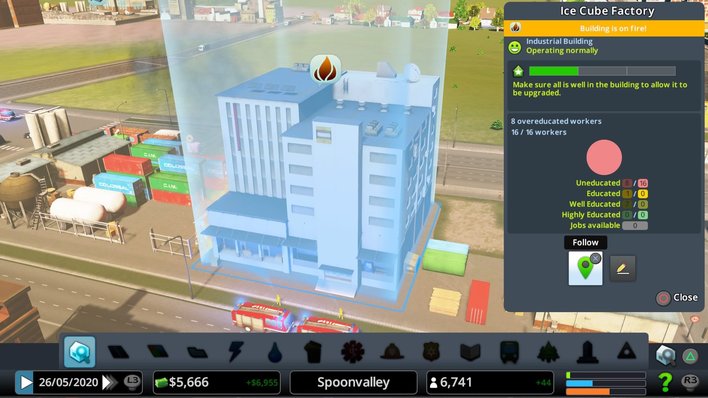
HOW DID THIS EVEN HAPPEN?!
OK, so we're exaggerating a bit. Cities Skylines is actually a lot more forgiving than we've just made out - and, for a game that requires you to keep so many plates spinning, it's a lot easier to pick up and play than you might expect. A city builder in the vein of Sim City, Cities Skylines starts you out with a barren expanse of land, and a fat wodge of cash in your bank, before asking you to build a civilisation out of nothing. With some nice chap having built a motorway that happens to stop right at the very end of your territory, all you really have to do is lead a few roads away from it, and start marking out "zones" where people can build houses, factories, office spaces, and other essential buildings to keep your city rolling. Rather than getting to plonk the houses down yourself, Cities Skylines' zone system instead leaves it to the free market. Every road you place has a number of squares running alongside it, which you can "paint" a certain colour, in turn determining what types of buildings can be built there. From low density housing to industrial factories, if you mark it (and you make your city attractive enough) companies will come and fill the space, and you'll start to have the seeds of your very own city.

Soon, there'll be plenty of high density shopping outlets popping up here...
Of course, you'll need more than just some buildings to make your metropolis a success - and in Cities Skylines, there's a lot of plates to keep spinning. Managing the town on a macro, rather than a micro scale, you'll be planning out public transport routes, building power stations, connecting up water pipes and ensuring you've got enough cops to maintain law and order rather than telling your residents where they should work, and what they should be wearing that day. Still, with so many people in your city, it's all too easy for things to suddenly spiral out of control - and your citizens can be a pernickety bunch.
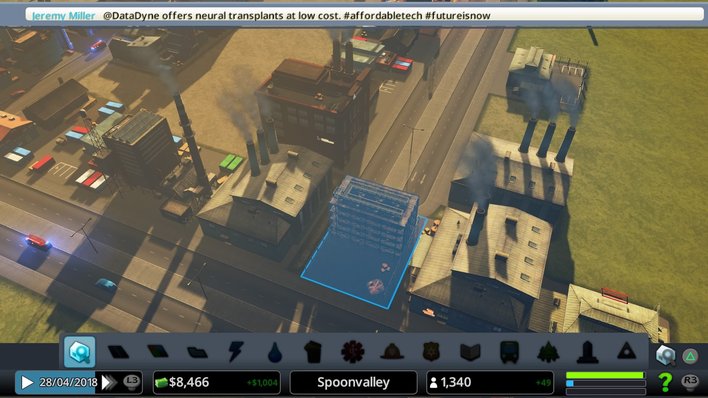
You get to watch buildings pop up - and best of all, they all have names, too. This here is Frank's Fish Stick Factory.
One of the first things you'll need to do is ensure your town has a clean supply of water, somewhere to store/deposit its sewage, and enough power to keep the TVs on late into the night. As you'd also possibly expect, there's more to this than you might imagine. Getting water into your town is a simple case of plonking a water pump somewhere near a clear patch of water - but figuring out where to let the sewage run into is another case entirely. It goes without saying that you don't want to put your sewage pipe upstream of where you're sucking the water out from, lest you end up with some funny tasting water, and a lot of ill citizens - but if you chose a seaside map like we did, making sure the two are far enough away from each other can be trickier than you'd think. Especially as the sewage tends to just pile up in the sea, slowly making its way towards your clean water pump...
But it's not enough to just build your sewage pump and clean water pump at polar opposite ends of the map - you'll also need to make sure the water can get around your city. As the water can't just jump around the map, you'll need to build pipes beneath the city to ensure the fresh water can get everywhere it needs, and the sewage can get taken away. It's easy enough to do in practice, but yet another thing to think about. Just make sure your pipes always join together... Unlike ours here...
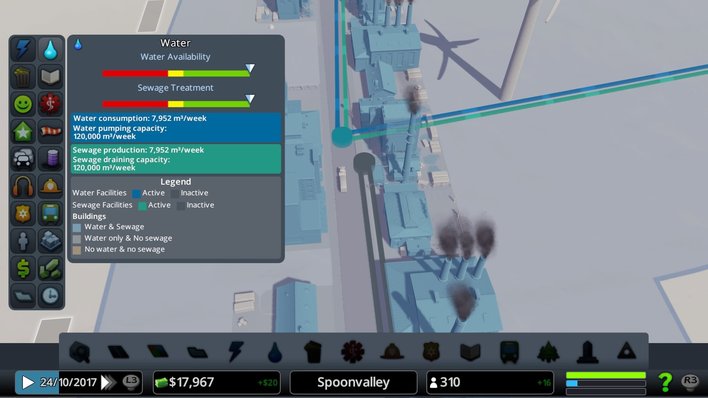
We were wondering why half the buildings were getting no water...
Luckily, energy is a little bit easier to handle - although again, it's symbolic of just how much you've got to think about in Cities Skylines. As in real life, Cities gives you a choice between new, "clean" energy, and the old fashioned, efficient-yet-dirty kind, with each having their drawbacks. Windfarms don't give out proper pollution - but they do cause noise pollution, meaning you won't want to stick them in the middle of suburbia. They also need to be built somewhere there's actually plenty of wind, with the power they kick out being determined by how much wind the spot catches. Old fashioned pollution energy, meanwhile, may kick out lots of dirt and grime, but it can keep the lights on day and night, providing orders of magnitude more power than windfarms, for not that much more dough.
But that's not all there is to think about with energy. While you don't have to lay down the electric cables yourself, energy will only "jump" from one house to the next if they're fairly close to each other. That means if you want to build your power stations out of town so the pollution doesn't destroy your residents, you'll need to build some overhead cables - or some buildings - to link the two neighbourhoods together. If you don't, well, you'll end up with something like this. Whooops.
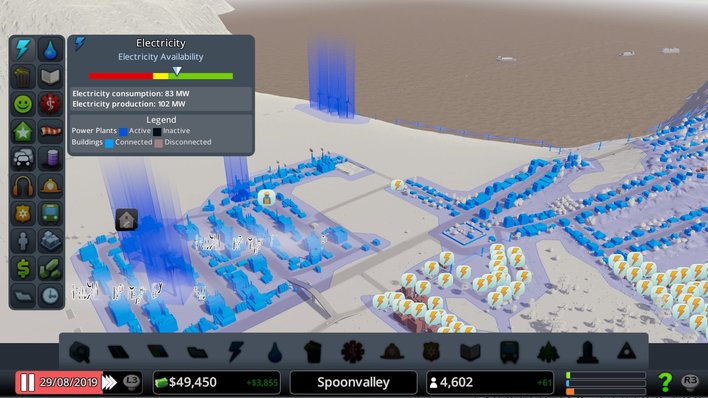
Electric production buildings have a deep blue glow.
And while water and electric are undoubtedly the two most important things you'll need to provide to your citizens, they're certainly not all. In order to be happy, citizens will need access to healthcare, schools, and even a local cemetery to dispose of the recently deceased. They'll want an efficient fleet of bin lorries to take away their rubbish (so long as they're taking it to a landfill that's miles away from their house), police stations nearby to maintain law and order, and a fire station that's at least fairly close to their house should the worst happen. And where you build your schools, fire stations and police headquarters is really important, as the layout of your roads will determine how large an area each can serve. Highlighting the roads they'll cover with a handy overlay when you place the building, you'll need to have a sensibly designed road network to ensure maximum coverage - and that raises so many more questions about how best to create your town.
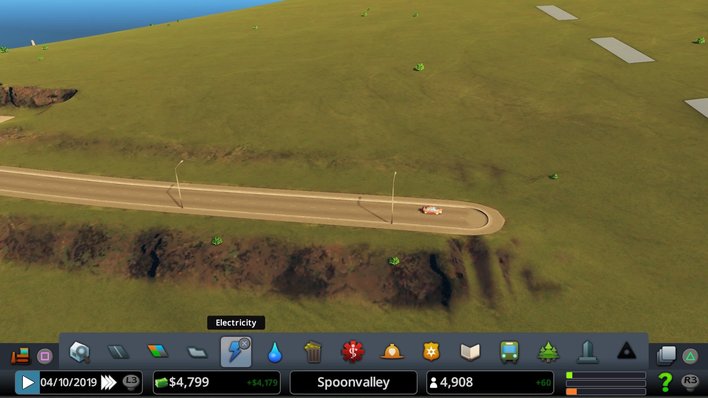
"For God's sake Susan, this is the last time we trust the sat nav..."
Luckily, though, the game provides a number of ways to make your life easier. For starters, you can easily upgrade roads should you need more traffic capacity - although as a six lane road takes up more space than a two lane one, you may end up losing a bit of building space when you upgrade it, and face having to wait for the buildings to be rebuilt. Buildings of all varieties will also tell you if they're ever short of anything, with handy pop up icons appearing when something's not quite right. Whether you've forgotten to stretch your water pipes to the end of your new estate, or you've expanded way beyond the limits of your power stations, you'll quickly learn when you're doing things wrong - and you can pause the flow of time to put it right. Sometimes you won't even need to build a new building, as increasing the budget for certain services lets them cover a wider area.
But one of the biggest challenges you'll face early on is that of money. Simply balancing the books is harder than it looks, especially when your fledging city's only just getting going. With such little money to play with, and so few citizens or businesses to tax, one wrong move, or one overly expensive outlay is all it takes to put you straight into the red, at which point you'll find it very hard to get out. Everything you build, and everything you do has some sort of weekly outlay associated with it, with buildings, services, public transport networks, and everything else in between having some sort of upkeep you need to pay. On the other hand, your income mostly comes from the taxes you charge your citizens and businesses - taxes that you can tweak yourself should you find yourself in a bind. Getting the right balance between encouraging new people into your city, while being sure you have enough capital to buy the things you need to keep your city running can take a bit of back and forth - but if you want to bypass the book balancing altogether, you can always turn on the unlimited money option before you start playing.
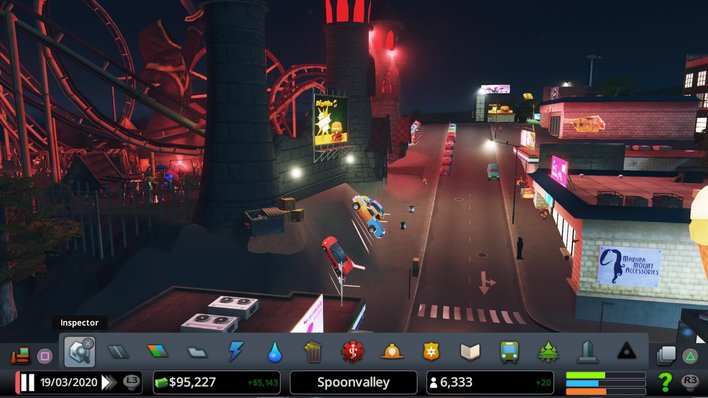
Industry grade handbrakes are a necessity for parking at the Magicka theme park
Getting the balance right in other parts of your city doesn't tend to be too bad either. While you can't be everything to everyone, treading the fine line between providing enough leisure facilities, good transport links, and all the basics without smoking your residents out of their homes doesn't tend to be too tricky - partially thanks to the aforementioned icons that pop up when you get it wrong, and partially thanks to the game's many, many overlays. Highlighting only the bits you need to look at, and letting you see at a glance which parts of your city are being missed out by your all important services, it makes plugging those few gaps in your citizen's happiness that much easier.
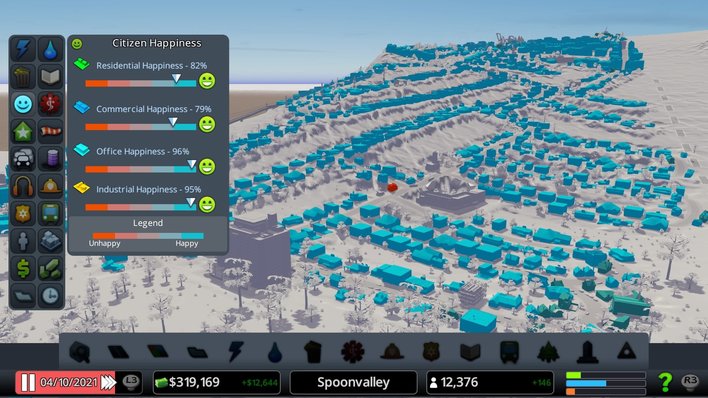
See that red house there? Yeah? That's us.
Yet it's a balance that never stops. The more people move in, the more jobs you'll need to provide. The more jobs you provide, the more pollution you'll end up with, the more water you'll need, the more electric you'll need, and you'll need a better road network/public transport system to boot. By design, you'll never reach that "zen" moment where everything just clicks, as there'll always be something that's running low, and something new to work at.
But as impressive as Cities Skylines may be, there's a fair few problems here. The first is that you'll often find your city ends up with a few traffic blackspots, where tailbacks really start to pile up. And while you can upgrade roads, or tweak them to become one way systems, etc, etc, the tools you have simply aren't strong enough to make your traffic flow properly. Rather than giving you slip roads, or just simple turnings, the game instead turns every intersection into a proper junction, where cars have to give way (or wait at traffic lights). Try as we might, we haven't managed to find an option to let you build slip roads, or simple turn-offs without the game automatically turning it into a traffic controlled junction. And while flyovers can often ease the pain a bit, actually building them is a lot harder than it should be, as the game has a nasty habit of trying to place the supports right in the middle of your other roads, rather than doing it cleverly.
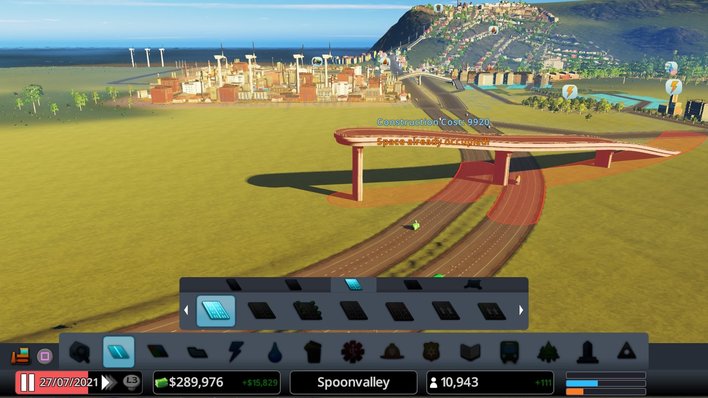
You can build a flyover here - but you'll need to spend ages moving it backwards and forwards (or even building it in sections) to get the game to plonk it down for you properly
We also had a few issues with public transport - like a railway station that was convinced it had no lines running to it, despite regularly having trains pulling up and dropping off passengers, and a bus station that seemed to be churning out a stream of infinitely spawning buses. But considering the complexity of what's being simulated here, there were surprisingly few technical issues.
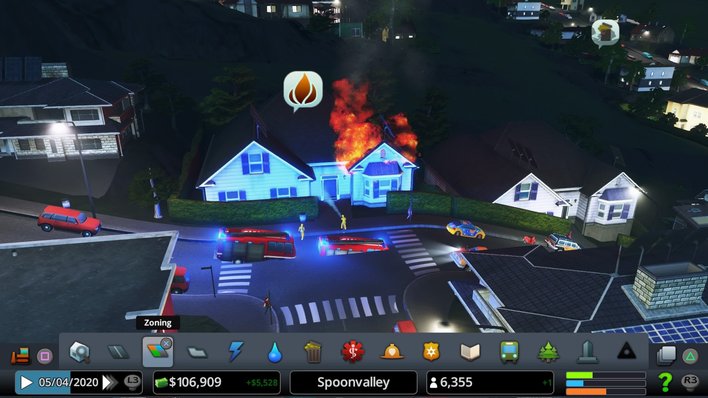
You know it's a bad fire when it seems to have melted the pavement
Instead, perhaps the biggest issue here is that there's no scenarios, or missions to complete. While there's a number of different starting territories you can try your luck at, the game will never give you any objectives to complete, or missions to tick off, instead letting you simply do your thing. And that's fair enough - but some sort of structured gameplay would provide a nice change, not to mention a bit of challenge, away from the sandbox mode. It's even stranger, as the game's trophies provide plenty of scope for experimental gameplay, asking you to create a city that survives a 40% crime rate for two or more years, or rule over a city with only 15% happiness, but it'd be nice to see these included in the game itself in some way. While there is an unlocks system, with new buildings becoming available as you increase your population, you'll have the same buildings and options to play with, no matter where you start.
And really, that's the only thing holding Cities Skylines back. Beyond the slightly dodgy road system, what you've got is a game that's both suitably complex, yet easy enough to pick up and play - a game that manages to be both completely absorbing, yet strangely relaxing at the same time. With a proper missions system, this would be a real must buy - but as it stands, it's still well worth a look.
Format Reviewed: Playstation 4


